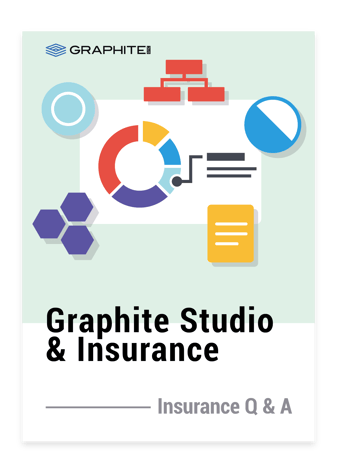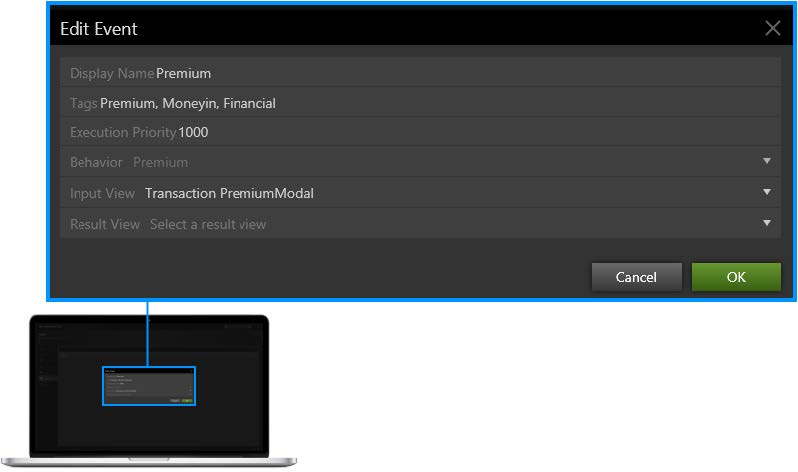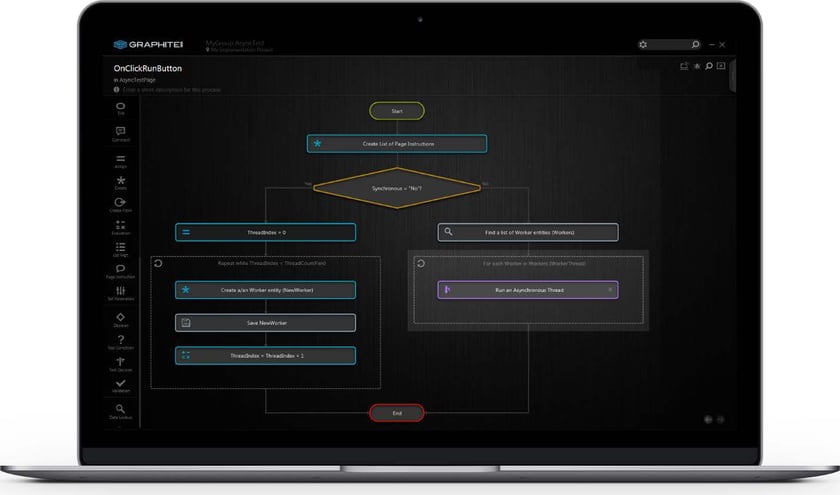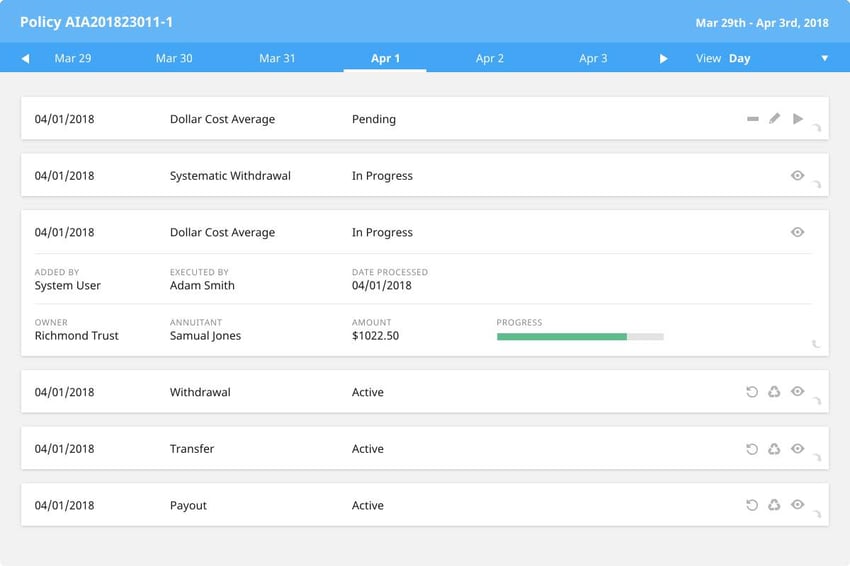
Graphite Studio™ and Insurance Q&A
Take the white paper with you, or read it below.
Scroll Down
Graphite Studio™ and Insurance Q&A
Click the links to go to a specific section.
- New Normals: The Composable Enterprise
- Business Transaction Processing
- Undo/Redo for Insurance Applications
- Nightly Batch / Asynchronous Processing
- How to List Key Events in a Timeline
- Insurance Q&A
New Normals: The Composable Enterprise
Insurance profitability, new markets, and premiums require broader underwriting risk assessments. These used to cost time, critical to turning around bound policies naturally. Such is the cost of legacy systems, constrained by limited resources and inflexible platforms. Underwriting, like Claims, Billing, and Policy Administration must support increasing productivity gains at the speed of business. Otherwise, risk falling behind in DPW, expense-ratio reductions, and lagging regulatory changes. It is not just innovation but on-demand innovation. Innovation is key to competitive Insurance advantages, so changing the way we change is what the industry needs. With customer expectations becoming more demanding every day, there is no waiting for improvements until next year or the year after.
In comes a better way to meet those business objectives. Now anyone can innovate - with software that creates software.
This is the age of low- and no-code. Write and visually describe your business and let the technology handle the technology. But not all low-code platforms are created equal. Some are missing critical enterprise-class capabilities that keep your environment safer, enable higher quality results, and support continuous improvements. And while the world changes faster than the Insurance industry can adapt, this is your opportunity to pull ahead. Here is how:
Case in Point
Expanding an Underwriting Process's Risk Assessment while Reducing Turnaround
An insurance carrier is heavily invested in an inflexible Underwriting system. While competing for new business in current and expanded markets, Actuarial and Underwriting leaders determined that writing a more profitable policy requires an ever-widening breadth of risk assessment. And reaching new markets means translating business rules to a supporting system before others, while preparing to process these increasing submissions.
But underwriters are already under pressure to turn around bound policies quickly. That is because, in today's digital world, customer expectations are rapidly increasing. For this carrier, it was time to look at what was holding them back from achieving a business solution.
The problem is that their static commercial-off-the-shelf (COTS) Underwriting system does not readily change. And replacing it is thought to repeat the same path to obsolescence the day after, until the next "lift and shift." And requesting funding for a better yet short-lived shelf-life fix was not politically feasible.
Starting with something practical
They determine they need a way to receive a submission with an attached ACORD document, pre-process as much of the usual preparatory work an underwriter does, while locating and expanding the volume of relevant risk-assessment supporting information. This enables the Underwriter, in record time, to apply their effort and talent to an increasingly complex decision process. The results sought are not only a leap in competitive advantages, but of an ongoing improvement ahead of other carriers as well. In other words, Underwriting becomes the proprietary business advantage. On-demand innovation is the key.
Introducing a Low- and No-code Application Platform, such as Graphite Studio™, allows anyone to compose solutions, from the Business Analyst to the early or experienced career developer. Capacity is key. And the guardrails for clean, secure, adaptable system creation are paramount for dependable, continuous improvement.
As a result, the solution was delivered in 87 hours. By a University Intern. After only 90 days of employment and a much shorter length of training. Coached by experienced professionals, there was an overall 6-12x improvement compared to traditional estimates for time, expense, and especially, timely business achievement. Connections between existing and new systems, information and devices using Graphite Studio™ produced the desired outcome for today and for whatever the possibilities of tomorrow present.
Every Insurance Company's Dream
Changes require traditional competitors to have a high degree of application skill, excluding departmental resources from reaching their respective objectives directly. Imagine your own Business Analysts and process professionals easily translating their plans, visually specifying flows, and crafting usability for targeted employees, partners, and customer use. Unlocking your existing professionals' capabilities is the key to innovative advantages.
Underwriting and Revenue are not the only aspects in need of competitive improvements. Profitability involves expense ratios. There are untold opportunities to reduce "swivel chair" manual work, improve the customer-agent-broker experience, reduce churn, and support field operations. Labor and talent are the most significant bottom-line operational expenses. And with hiring scarcities, the right strategy solves both a shortage and the expense simultaneously. Changing how we change is what we've always done, or we would all be riding horse and buggies and using hallway phones instead of now carrying them in our pockets.
The world is changing faster than ever
Daryl Plummer put it best in his recent Keynote kicking off Gartner's Virtual Technology Growth and Innovation Conference, your infrastructure "must not be built-to-last, but, built-to-change." Here is where the Composable Enterprise is the new normal.
In a perfect world, you would want systems that were not only built to change, but also built to last. That’s what Graphite Studio offers.
Claims, Billing, and Policy Administration legacy systems also need to orchestrate new experiences. It is about fitting the customer's ecosystem, not the other way around. Connecting anchored Insurance applications to the world of information for those that need it enables timely business opportunities for economic value, growth, and stability.
So how can new carriers and syndicates become Composable Application business enablers to accelerate closing this gap between need and execution?
From years in the insurance industry, we have learned that if you can accomplish the following better, faster, and more cost-effectively than others, you win. There are guardrails, lessons learned and must-haves you may not have yet considered in the "anyone can now innovate" world. Look out for:
Security: You have got people for that. And they will set the bar high, offering to help sometime next year or the year after. Having built-in capability in your low- or no-code platform of choice to meet various security needs makes it easy to pass their requirements. Reducing vulnerabilities like keeping bad actors from peeking at your information. Not having to craft, but merely configure, "role-based usage." Role-based usage allows you to access everything, but certain users need only use part of the application or information access. There is much, much more to this topic that your security staff will be pleased that you're addressing it so well.
Scale and structured costs: Whatever you create should be your own. And your success should not punish you with increased costs. Creating traditionally "hand-coded" applications enables control over the outputted product, usually without "runtime dependencies." When you select the wrong low-code application platform, you could be saddled with such a forever partnership, tied to the fate of the tool. Further, some may surprise you with costs scaled to users. Consider platforms that produce "source-code" without "runtimes" that also charge by the application, not by the vast number of end-users your success indicates, only to be dampened by mounting, scaled costs.
Clean code and best practices: The only thing that never changes is change. If your creation is built to change, rather than only built to last, then the result is highly maintainable. Change is not a one-time event but continuous improvement. Poor practices compound "technical debt," which slows down innovation and increases overhead from structure to documentation. The right platform is the right strategy. See how the system leverages “objects” and all their benefits. Particularly how the platform architecturally lends itself to optimum modularity, composability, and conveniences.
Composability: Again, if you think of blocks and know your business, you can innovate. That's if you have the right platform. Usability drives adoption, and therefore the success intended. "User-interface (UI)" elements, like those you see online or on mobile devices, are the look and feel of the innovation. Being able to apply your UI design readily, or that of the corporation, UI consultant, etc., is the collaborative, productive capability you will be glad you required. Using prebuilt business components that come with the platform and those your more experienced staff can build, enable drag and drop use for rapid, accurate, and capable systems.
Ecosystem: It is a platform world. Not only referring to the platform you use to build your creation, think of your creation as a platform. One that readily connects with others. And to other information, wherever that may be available today or become available later. Perhaps focus on continuous value creation with ecosystem partners rather than project-thinking. Connecting through "Services" is the way and bigger than what is covered here. It is a start to let you know that Graphite Studio™ makes using "Rest," "SOAP," and "GRPC" as easy as drag and drop, once built, installed or consumed, for business use. You can also "publish" your own connections as conveniences for your business, again leveraging more skilled staff as enablers.
The rest of this document covers just a few of the dozens, if not hundreds, of insurance-ready capabilities that exist, putting innovation-driving business achievement within your control. Please pass the rest of this document to Business Analysts, process professionals, and any developer resources that enable business improvement.
If sustained competitive advantage, resiliency, and business agility are your goals, this is more of a strategic decision that points to few, if not just one choice. Graphite Studio™ accelerates getting more value from existing systems and rapidly builds new ones with low- and no-code enterprise-class business capabilities. Today, if you can think it, you can innovate. And the advantages belong to the innovators.
2. Business Transaction Processing
In Graphite Studio™, any 'behavior' can be turned into a business transaction. These behaviors, called Events, can either be scheduled to be processed by nightly batch using the Schedule Event shape or processed immediately using the Run Event shape.
Both the Event shapes associate the processing of a behavior with a specific User and System Date. This feature allows applications built using Graphite Studio™ to contain a timeline of transactions for any entity.
Events processed maintain a data hierarchy of the associated Entity, both before and after the Event. This feature can be used effectively in insurance applications to show how a business transaction has affected a policy, a role, a premium, etc.

The Event setup dialog allows a content developer to set up execution priority, custom input, and result Views for each of the Events.
Events can also be exposed as SOAP or REST services, enabling the development team to create a services layer using Graphite Studio at a rapid speed.
3. Undo/Redo for Insurance Applications
Processed Events can be reversed to move the Entity back to the state it existed before the Event's processing. Use this feature in insurance applications that need to provide a clean reversal of financial processing when an error has occurred due to incorrect data entry or other business circumstances.
In most cases, undone Events need reprocessing. Graphite Studio™ provides the capability to automatically add a pending Event to fix the error and reprocess the Event.
In some cases, such as disbursement processing, a simple Undo of an Event will not suffice, and the Undo and the Redo process will need custom logic. Graphite Studio™ provides the capability to build a custom Undo Behavior and/or a custom Redo which will automatically invoke when an Event is undone or reprocessed.

4. Nightly Batch / Asynchronous Processing
The Graphite Studio™ platform comes with a windows service-based batch processing mechanism. These services run across a webserver cluster to facilitate the batch processing to scale horizontally.
The batch processing windows service is lightweight and contains a scheduling mechanism to process the scheduled Events.
Graphite Studio™ also provides the capability to process Behaviors asynchronously. The Asynchronous shape is used in a Behavior to invoke any Behavior asynchronously.

Since the Asynchronous shape uses the underlying Graphite Studio™ batch windows service, asynchronous processing can be spread across webservers. Thus truly providing a scalable multi-threading architecture.
5. How to List Key Events in a Timeline
The Graphite Studio platform comes with a windows service-based batch processing mechanism. These services run across a webserver cluster to facilitate the batch processing to scale horizontally.
The batch processing windows service is lightweight and simply contains a scheduling mechanism to process the scheduled Events.
Graphite Studio also provides the capability to process Behaviors asynchronously. The Asynchronous shape can be used in a Behavior to invoke any Behavior in an asynchronous fashion.

Graphite Studio™ provides a set of powerful UI widgets that process Events and display Event details. The Timeline View Element delivers the ability to display Events in chronological order. The Event Display Panel/Detail View Elements can process, show business validations, reverse and redo an Event.
.
6. Insurance Q&A
1.What features exist to support an automated deployment pipeline?
a. Test-Driven Development?
Graphite Studio™ promotes Test-driven design by offering the capability to create unit tests during the development process visually. These unit tests are executed and validated before deploying to a server for Quality Assurance Testing.
b. Automated regression testing?
Graphite Studio™ will directly fit into your current Software Development Life Cycle, shortening the development and unit testing phases. Graphite Studio™ will preserve the customer's approach if a customer currently has a methodology for regression testing.
c. Build automation?
Graphite Studio™ provides a headless service that can build and deploy applications. Graphite Studio will preserve the customer's approach if a customer currently has a methodology for build automation.
d. Containerization?
All Graphite Studio™ generated applications are standard .NET Web Applications and can be containerized like any .NET Web application.
2. How does the product scale?
a. Can session state be managed across a server cluster?
Graphite Studio™-generated applications are completely stateless on the server-side, allowing applications to scale horizontally without a need to worry about server-side sticky sessions or other mechanisms for the preservation of server-side state between calls.
b. How do you scale?
Graphite Studio™ generated applications scale horizontally on the Web-tier through the use of web server clusters. As Database requests/demand increase, we recommended scaling vertically by increasing the resources available to the Database Server, following traditional Microsoft recommendations; scale-out in the Web-tier and scale-up in the Database-tier.
3. How flexible is the UI design facility?
a. Can we implement our Enterprise Style and Pattern libraries easily? (Custom JavaScript components)
Graphite Studio™ offers an extensive amount of User Interface Elements from our libraries. These UI Elements visually create custom screens based on the customer's needs. If a new UI Element is needed, the customer can easily include it by writing a small amount of JavaScript and CSS. Graphite Studio provides a conduit to bring in any traditionally developed artifact.
4. Can we easily implement our Enterprise Style and Pattern libraries?
a. JavaScript beacon, CLR monitoring, etc…
Graphite Studio™ generates a standard MVC web-based application with HTML5, CSS3, and JavaScript. Hence any industry-standard monitoring tools can be used to monitor the generated application at every tier.
5. What Databases are supported?
Graphite Studio™ directly supports SQL Server Enterprise, SQL Server Standard, SQL Server Express, and Azure SQL. However, additional databases can be supported by writing a custom Repository layer leveraging our extensibility or service features.
6. What API / web service capabilities exist?
a. Can we expose reusable components to external consumers? (i.e., micro-service architectures supported?)
When using Graphite Studio™, the customer can create both small to large-scale applications. Graphite Studio also supports building libraries used to share functionality across projects. Any behavior in a library or a project can be exposed as a web service with the push of a button, both SOAP and REST. REST Services generate OpenAPI (Swagger) documentation.
b. How easily can the product consume 3rd party APIs and SOAP services?
Graphite Studio's Extensibility and Services features make it easy to integrate with any third-party system or middleware.